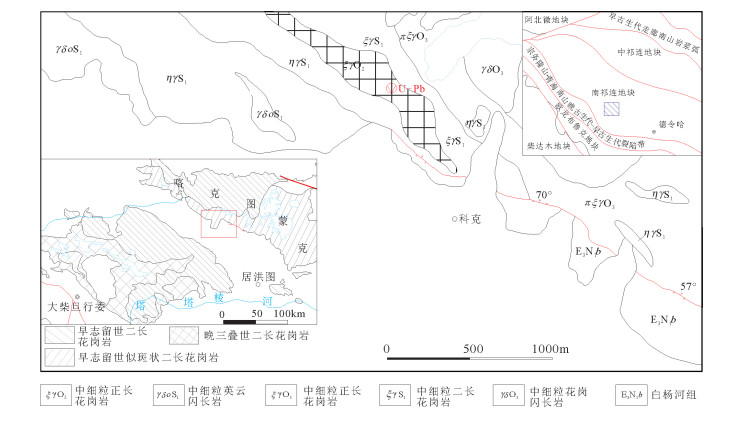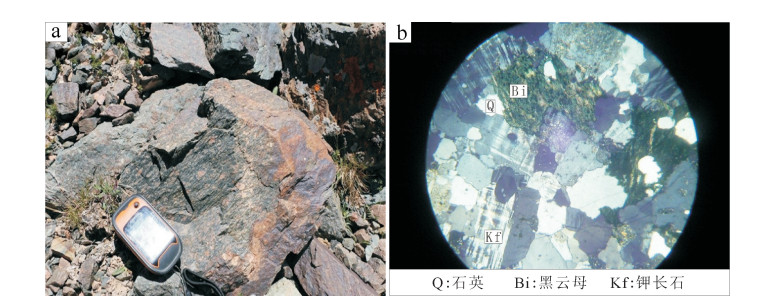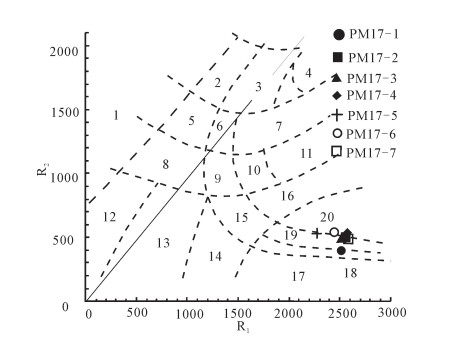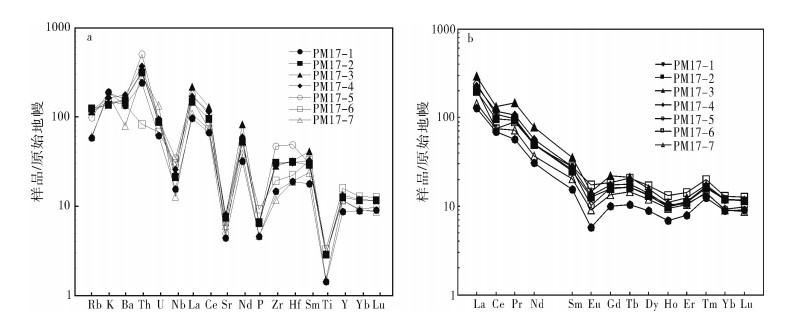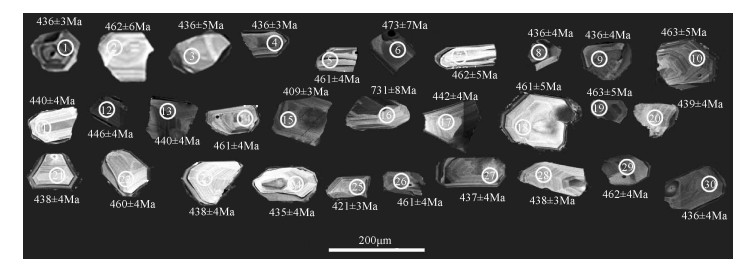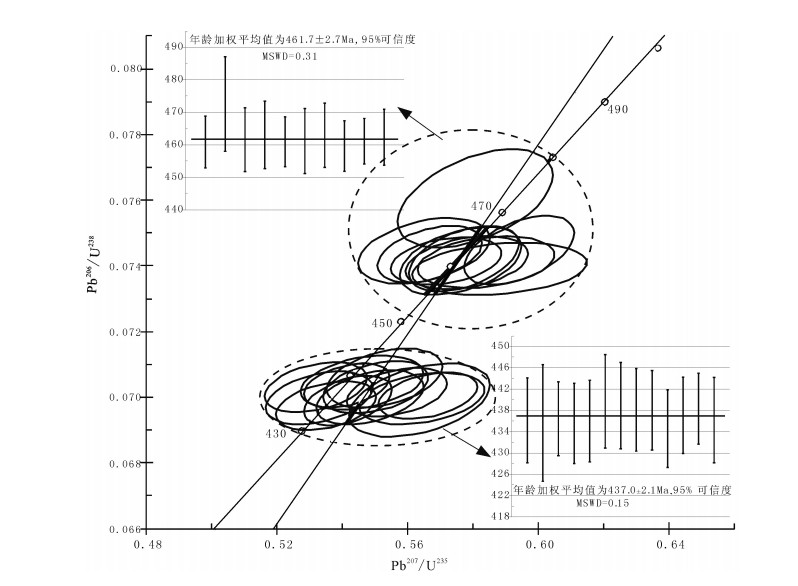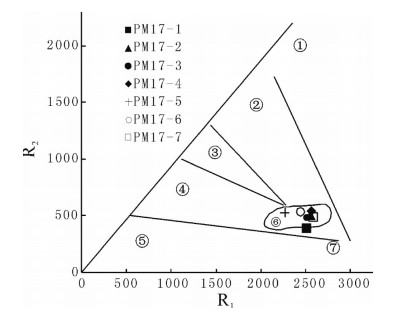Geochemical characteristics and formation age of Keke Pluton in South Qilian Mountain, Qinghai Province
-
摘要:
为探讨南祁连喀克图蒙克山科克岩体的构造属性,对南祁连喀克图蒙克山中奥陶世科克岩体进行了详细的地球化学和定年研究。研究结果表明,该岩体主体岩性为正长花岗岩,具有高SiO2(68.41%~73.10%)、高Al2O3(13.03%~14.35%)的特征,亏损高场强元素Nb、P、Ti和重稀土元素,发育明显的负Eu异常,反映岩石经历了强烈的分离结晶作用,其稀土元素配分曲线类型与壳源花岗岩相似;构造成因分类图解表明,这些花岗岩属同碰撞环境的产物。LA-ICP-MS锆石U-Pb测年结果表明,岩体形成于461±2.7Ma,时代为中奥陶世,表明该岩体的源岩为壳源或壳幔混合的产物。结合区域地质特征认为,该岩体为同碰撞作用的产物,佐证了南祁连地块在奥陶纪处于挤压状态,对进一步研究南祁连造山带的演化具有重要意义。
-
关键词:
- LA-ICP-MS锆石U-Pb测年 /
- 地球化学 /
- 南祁连
Abstract:Lying in the middle of Kaketumengke Mountain, the Keke pluton which was formed in Middle Ordovician is located in the southeastern part of South Qilian massif. Geochemical and geochronological studies were conducted to investigate the tectonic at-tribute of the Keke pluton. The pluton is mainly composed of syenogranite and is characterized by high content of SiO2 (68.41%~73.10%) and high content of Al2O3 (13.03%~14.35%). Geochemical data also show depletion of Nb, P, Ti and HREE with Eu nega-tive anomaly. The REE patterns show the characteristics of crustal anatectic granite, and the genetic classification diagram shows that the granite was formed in a syn-collisional setting. LA-ICP-MS zircon U-Pb dating shows that gneissic granite was formed at 461±2.7Ma. Combined with regional geology, the authors hold that Keke pluton was probably derived from the source of the crust and re-sulted from syn-collision, which supports the argument of compressive regime of the Qilian block during the Mid-Ordovician and is of great significance for the further study of the evolution of the Qilian block.
-
Keywords:
- LA-ICP-MS zircon U-Pb dating /
- geochemistry /
- South Qilian Mountain
-
广西南丹大厂是世界级的特大型锡多金属矿田,是中国第二大产锡基地,位于江南古陆西南缘、右江盆地的北东侧。前人对大厂锡多金属矿田矿床成因、成矿时代、稀散元素等开展了大量研究工作[1-5]。对于大厂锡多金属矿田的矿床成因,依然存在争议,争论的焦点主要集中在它们是泥盆系与海底火山作用有关的同生矿床,还是燕山期与笼箱盖花岗岩相关的岩浆热液矿床。陈毓川等[1]、蔡明海等[2]认为大厂矿田形成于燕山期,属于岩浆热液充填-交代型矿床,与笼箱盖花岗岩有关;秦德先等[3]、Yan等[4]则认为该矿床属于同生热水喷流沉积型或与海底火山喷发有关的矿床,矿床形成于泥盆纪,成矿与花岗岩无关;邵主助等[5]通过总结前人的研究结果,认为大厂锡矿床形成于燕山期,属后生充填-交代矿床,与龙箱盖花岗岩有关。
大厂笼箱盖岩体的侵位期次、与成矿的关系、构造环境背景等受到了地质学家的高度关注,其成岩年代学的研究自然成为了众多学者的研究重心。前人尝试用各种方法测试笼箱盖岩体的成岩年龄,李华芹等[6]利用原位SHRIMP U-Pb法和全岩Rb-Sr等时线法测得笼箱盖含斑黑云母花岗岩锆石年龄分别为94±4 Ma和98.6±1.9 Ma;梁婷等[7]利用LA-MC-ICP-MS锆石U-Pb原位定年方法,测得笼箱盖复式岩体中单颗粒锆石的206Pb/238U年龄为103.8~102 Ma、96.6~93.86 Ma、90.1~85.1 Ma;陈毓川等[1]测得笼箱盖复式岩体中细粒黑云母花岗岩的全岩年龄为138.6 Ma,黑云母花岗岩全岩年龄为140 Ma。但积累的年代学数据依然不够,热年代学手段较单一,运用裂变径迹年代学的研究内容鲜有报道,无法对该区构造-热事件年代学进行良好的约束,在一定程度上制约了区域构造-热事件对矿床成因影响的科学理解。
裂变径迹年代学作为国际前缘年代学技术,以其研究载体矿物(锆石、磷灰石等)在重塑地壳上部几千米内数百万年以来的热历史方面显示出巨大优势[8-14]。裂变径迹技术能够记录构造-热时间的年龄,反演构造-热事件,在过去三十多年里,已经被广泛应用于许多火成岩、变质岩和沉积岩[15-16]。无论国内还是国外都已经开展了许多相关的应用研究[11-14, 17-22]。锆石裂变径迹是解决成岩成矿年龄、岩体热历史反演、构造区热事件演化及上升速度等多个领域的可靠且有效手段。本文通过裂变轨迹反演大厂地区构造-热事件演化史,建立该区构造-热演化事件的时间格架,从区域上约束热事件演化过程与构造演化机理,认识构造演化的地球动力学背景,为解决大厂地区矿床成因等科学问题提供新证据,为指导深部及外围找矿提供理论支撑。
本文对大厂矿田笼箱盖岩体的锆石裂变径迹年龄开展研究,通过对其黑云母花岗岩进行年龄厘定,获得了3组新的锆石裂变径迹年龄数据。划分了该岩体的侵入期次,约束构造-热演化过程,为进一步探讨矿区侵入岩与成矿关系、成矿动力学背景、矿床成因等提供新的可靠依据,也为揭示大厂多金属矿田地区的深部地质过程、指导进一步找矿提供新的佐证。
1. 区域地质背景
丹池成矿带处于江南古陆西南缘、右江盆地东北部,是中国重要的有色金属成矿带[23-25],北起芒场、大厂,往南延伸至芙蓉厂、九圩一带,呈NW向带状分布,长约100 km,宽约30 km,受EW向基底断裂与NW向丹池深大断裂控制。西矿带位于大厂褶断带,主要由NW向大厂背斜和大厂断裂组成。该褶断带控制着长坡-铜坑、巴力、龙头山锡石-硫化物矿床[1-2, 25]。区域构造活动强烈,持续时间长,造成区内褶皱构造形态极复杂,但总体构造线仍以NW—SE向为主,其次为EW向、SN向,其他方向的褶皱仅在局部见到,规模小、形态幅度也小。与褶皱构造一样,丹池成矿带断裂构造非常发育,形态分布、活动特征复杂,按构造线展布方向可以分为NW—SE向、NE—SW向、EW向和SN向,其特点均以陡倾断层为主。
区内晚古生代及中生代地层发育,尤以泥盆纪地层独具特色。丹池成矿带上锡多金属矿赋矿层位主要为泥盆系,石炭系、二叠系中仅见到极贫的晚期(后生)方解石石英脉含铜、铅锌等矿化,均不形成工业规模。泥盆系岩性组成自下而上为:中泥盆统纳标组(D2nb)黑色泥岩、页岩和礁灰岩,中泥盆统罗富组(D2lf)粉砂岩、泥岩夹泥质灰岩;该层主要分布于大厂矿田中矿带、西矿带、北香地区,龙头山特富矿体即赋存于该层。上泥盆统榴江组(D3lj)和五指山组(D3w)为硅质岩、条带灰岩及扁豆灰岩,泥灰岩夹钙质页岩、砂岩、炭质页岩等;该层分布于丹池背斜两翼,在大厂矿田内主要分布于大厂背斜两翼及宽洞向斜的冀部,也是丹池成矿带上的主要赋矿层位。
丹池成矿带岩浆活动较强烈,主要为燕山中、晚期的花岗质岩浆活动,表现为中酸性岩浆的侵入,形成黑云母花岗岩、花岗斑岩、石英闪长玢岩、石英斑岩、英安斑岩、白岗岩和少量辉绿玢岩等。岩浆活动集中表现在区内的隆起区段,在非隆起区段目前还没有发现岩浆岩,具体表现为NW向褶断带与矿带内的近SN向的断块隆起带交汇部,沿隆起带边部SN向基底断裂侵位。岩浆岩主要以隐伏岩体形式产出,在地表出露有限,仅见断续出现的岩脉及隐伏岩体顶部的少量岩枝、岩墙等,在芒场、大厂部分地区有岩脉出露,其深部均有花岗岩枝。五圩、北香等隆起区段地表虽无岩浆岩出露,但地质和物探资料显示其深部有花岗岩体的存在。
丹池带上的矿化分带性多局限于“上锡、下铜、中间锌”,“近铜、远锡”的认识,从区域上看,东西方向上以NW向丹池背斜为中心,往东西两侧背斜冀部、南北方向上以大厂矿田为中心,可以简单划分为3个带(隆起区内除外):中心Ⅰ带为Sn-Zn-Pb-Sb-Bn组合,其中以Sn、Zn为主,富黄铁矿、铁闪锌矿,地层中富Ba;往外Ⅱ带为Zn-Pb-Sb组合,以Zn、Cu、Pb、Sb为主,也含Sn、Cu、Ag,富集磁黄铁矿、铅矿物;Ⅲ带为Pb-Sb-Ag-Hg-Sn-Zn组合,金属含量较低。
2. 矿区地质背景
大厂锡多金属矿集区位于华南板块内扬子陆块与南华活动带之间过渡带中的江南地块西南区,丹池大断裂从该矿田东部穿越[1-2, 25]。丹池构造带中的隆起区是丹池成矿带上最重要的构造区段,大厂矿田就是丹池带上最典型的隆起区(图 1)。
![]() 图 1 大厂矿区综合地质图[26]Figure 1. The location oftailings storage in the Dachang mine
图 1 大厂矿区综合地质图[26]Figure 1. The location oftailings storage in the Dachang mine大厂锡多金属矿田褶皱、断裂构造比较复杂(图 1)。矿田内发育一系列NW向褶断带和NE向断裂带,两者交汇部位有利于岩浆热液活动和矿液的聚集。矿体沿NW向构造分布,根据成矿构造的不同特点及矿床产生部位,以及矿化的特点可将矿田分为西、中、东3个构造成矿带。西带由NW走向大厂倒转背斜和NW向、NE向断裂组成,NW向延长8~10 km,断裂带控制宽800~1000 m;中带由丹池断裂和丹池背斜组成,NW向延长15 km,断裂构造控制宽500~800 m,NW向和NE向构造交汇地段有斑状黑云母花岗岩和等粒黑云母花岗岩侵入;东带以NW向断裂为主,走向长8~10 km,断裂控制宽600~900 m。大厂矿田NW向构造和NE向构造的交汇发育,构成大厂矿田构造的基本骨架,控制矿床和矿化区的产出位置,形成矿田矿化分布的基本模式。
大厂锡多金属矿田主要出露泥盆纪、石炭纪和二叠纪硅质岩和碳酸盐建造,其中上泥盆统榴江组和五指山组是大厂锡矿主要的赋矿层位(图 1)。在大厂矿田内部,下泥盆统出露较少,多在背斜核部呈隐伏状,东矿带则出露较好。中泥盆统主要分布于大厂矿田中矿带、西矿带,北香地区地表也有大面积出露,岩性变化及厚度差异均较大,其上部为含生物结晶灰岩、泥灰岩、页岩,下部为生物礁灰岩,深灰色条带状结晶灰岩和结晶生物灰岩,礁灰岩变化极大,龙头山礁灰岩基底为生物屑泥灰岩,盖层为黑色泥页岩、泥灰岩,龙头山特富矿体即赋存于该层。上泥盆统分布于丹池背斜两翼,在大厂矿田内主要分布于大厂背斜两翼及宽洞向斜的冀部,其岩性为硅质岩、条带灰岩及扁豆灰岩,泥灰岩夹钙质页岩、砂岩、炭质页岩等,也是丹池成矿带上的主要赋矿层位。
大厂锡多金属矿田的岩浆活动以中-酸性侵入岩为主,出露面积小,主要分布在矿田中部的笼箱盖复式岩体和笼箱盖及铜坑-长坡-巴里-龙头山-高峰矿区的东西两侧[27]。岩石类型主要有黑云母花岗岩、斑状黑云母花岗岩、花岗斑岩、(石英)闪长玢岩、英安玢岩、白岗岩、石英斑岩等。黑云母花岗岩见于大厂矿田拉么笼箱盖、芒场大山等地,呈隐伏岩株状产出。花岗斑岩呈岩脉状,见于大厂长坡和芒场大山,空间位置上产出于隐伏的黑云母花岗岩上方,最典型的笼箱盖和铜坑-长坡-巴力-龙头山2条花岗斑岩脉均沿SN向断层侵位于泥盆纪—石炭纪地层中,在地表断续出露。石英闪长玢岩和英安玢岩分布于大厂矿田西矿带东侧,呈岩墙状,近SN向分布,倾向E,倾角约70°,岩性变化较大。明显受SN向断裂控制。白岗岩和石英斑岩分布于笼箱盖隐伏的黑云母花岗岩岩株边部,沿断裂和层间断裂充填形成岩株、岩床或岩枝,规模较小。
大厂矿田内矿化分带主要表现在其矿化类型、矿体形态、元素组合和矿石矿物组合呈现有规律的带状分布。矿田内由笼箱盖岩体向外,其矿化类型和成矿元素组合呈现出带状分布的特点。矿田中带发育有受岩体控制的矽卡岩型锌铜锡矿化及叠加其上的晚期SN向钨锑矿带(以拉么、茶山为代表);岩体外围东西两侧,受NW向构造和地层的控制,形成了NW向大福楼-坑马和EW向长坡-雷打石(以长坡、铜坑、龙头山为代表)2条锡多金属矿带。按矿化金属元素组合,大厂矿田具有如下4种元素组合类型:Zn-Cu型(拉么);W-Sn-Pb型(茶山);Sn-Zn-Pb-Sb型(西矿带的长坡、铜坑、龙头山);Sn-Zn型(东矿带大福楼、坑马)。大厂矿田及外围具有较明显的垂直分带特征, 代表性矿床有长坡矿区和大福楼矿区,均具有上部为脉状、细脉状、网脉状的锡金属矿体,下部为顺层分布的层状、似层状锡多金属矿体。
3. 岩体特征及样品描述
笼箱盖岩体是位于大厂锡多金属矿田中部的笼箱盖地区规模最大的侵入体。地处NW向丹池褶断带与NE向断裂构造的交汇处,侵位于泥盆系碳酸盐岩-碎屑岩建造中,岩体的分布走向与主构造线方向一致[28]。该岩体地表出露较少,仅见含斑黑云母花岗岩呈近SN向的脉状和岩枝状产出,主体以隐伏岩体形式出现[1]。
笼箱盖岩体地表为SN走向的陡倾黑云母花岗斑岩脉,深部为呈三角形展布的岩株。根据钻孔和重力资料,岩体向深部呈巨大的岩基,呈上小下大的锥状,且西陡东缓,向下一直延伸到铜坑-长坡矿床的深部,已有钻孔控制的面积约为21 km2[2]。本次研究样品(LXG-01、LXG-03、LXG-04)均采自笼箱盖岩体的黑云母花岗岩,采样位置如图 1。黑云母花岗岩呈灰白色,花岗结构,块状构造,主要矿物成分为石英、钾长石、斜长石、黑云母,副矿物有锆石、磷灰石、钛铁矿、黄玉、电气石等,发育少量长石斑晶。
石英呈半自形-他形产出(图版Ⅰ-a),晶粒大小悬殊,多数为0.2~0.5 mm,内部裂隙发育,常被黑云母、斜长石、钾长石交代呈港湾状(图版Ⅰ-e、g、i),局部颗粒内部被斜长石交代呈圆形孔洞(图版Ⅰ-f)。斜长石呈浑圆状,泥化严重,常呈不规则状、星点状分布于钾长石上,具卡式双晶,颗粒大小主体为0.4~0.6 mm,常交代黑云母与石英,呈港湾状(图版Ⅰ-a、b、e、i)。钾长石交代残余呈条纹状,表面带脏感,颗粒大小较大,0.6~0.8 mm裂隙发育,泥化的钾长石呈卡斯巴双晶(图版Ⅰ-c),交代石英呈港湾状(图版Ⅰ-h)。黑云母正交光下呈紫色、绿色、黄色等,颗粒不规则分布(图版Ⅰ-d),含量较少,节理明显,常被斜长石、钾长石交代呈港湾状,同时自身也交代石英(图版Ⅰ-e)。
4. 裂变径迹分析方法
样品经过粉碎后,采用标准的磁选和重液分离技术,从破碎的岩石样品中提取磷灰石和锆石颗粒。样品粉碎至颗粒尺寸与岩石中矿物的大小相适应,通常约为60目;利用传统方法粗分离后,采用常规破碎、磁选、重液分离等技术对样品进行分离。锆石和磷灰石的处理方法有所不同。锆石颗粒均匀撒在载玻片上,用1.6 cm×1.6 cm的Teflon片轻轻盖在颗粒上,然后置于加热台上加热的同时垂直用力摁压,直至锆石镶嵌在PFA Teflon片中;第二个步骤为抛光,砂纸依次为500#、1200#、2400#,金刚砂依次6 μm、3 μm、1 μm,垂直用力,边磨边旋转,直至揭出锆石的最大面;使用摩尔比值为NaOH/KOH(=1:1)共溶混合物蚀刻样品,时间为25 h,加热台温度为210 ℃;然后采用无铀云母片与样品叠加,胶带固定三角扎孔定位,样品、标样(FCT)、标准玻璃(CN5)按照顺序置于辐射罐中,通量一般选择1.2×1015 cm-2·s-1;最后是云母蚀刻,分离云母和样品靶,在40%HF中蚀刻云母20 min取出后洗干净,保证样品靶不要弯曲,进入样品统计。
裂变径迹中心年龄[29]采用IUGS推荐的Zeta校准方法计算[30],依据Green提出的方法计算误差[31]。本次实验锆石的Zeta值分别为102.1±3.8,P(χ2)用来评价所测单个粒子属于同一年龄组的概率;当P(χ2)>5%时,裂变径迹样品含有单一年龄群体[32],当P(χ2) < 5%时,表明单颗粒年龄不均匀分布,不服从正态分布,需要使用BinomeFit软件[33]对裂变径迹年龄进行分解。
5. 分析结果
表 1和图 2为3份样品的锆石裂变径迹数据分析结果。研究结果表明,3份锆石样品的χ2检验均不合格(P(χ2) < 5%),表明样本的单一年龄是分散的,属于混合年龄。因此,需要对χ2检验值小于5%的3个不服从正态分布的样品使用二进制软件[33]进行分解裂变径迹年龄,分解结果如图 3所示。
表 1 锆石裂变径迹结果Table 1. Zircon fission track result样号 岩性 颗粒数
/nρs/(105·cm-2)
(Ns)ρi/(105·cm-2)
(Ni)ρd /(105·cm-2)
(Nd)P(χ2)
/%中心年龄
/Ma±1σ池年龄
/Ma±1σLXG-01 黑云母花岗岩 25 141.281(6444) 107.013(4881) 18.062(8055) 0 121±7 121±5 LXG-03 黑云母花岗岩 21 99.661(3566) 96.699(3460) 17.604(8055) 0 91±5 92±4 LXG-04 黑云母花岗岩 16 139.83(3615) 120.025(3103) 17.259(8055) 0 102±6 102 ±5 注:Ns为自发径迹数,Ni为诱发径迹数,Nd为标准铀玻璃的外探测器白云母记录的径迹数;ρs、ρi和ρd分别为与Ns、Ni和Nd相对应的径迹密度;n为径迹的条数,P(χ2)为χ2检验几率,锆石年龄运用ζ(Zeta)=90.9 ±2.8(yrcm2/tr)进行计算 样品LXG-01的锆石裂变径迹的中心年龄为121±7 Ma(表 1;图 2和图 3),24个独立个体年龄在189.55~92.67 Ma之间,通过对其进行二项分解可以得到2个年龄组:106.8 Ma(P1)和151.2 Ma(P2),以106.8 Ma为主导。样品LXG-03的锆石裂变径迹的中心年龄为91±5 Ma(表 1;图 2和图 3),20个独立个体年龄在124.96~63.95 Ma之间,通过对其进行二项分解可以得到2个年龄组:77.2 Ma(P1)和101.7 Ma(P2),以101.7 Ma占主导。样品LXG-04的锆石裂变径迹的中心年龄为102±6 Ma(表 1;图 2和图 3),15个独立个体年龄在140.84 ~78.28 Ma之间,通过对其进行二项分解可以得到2个年龄组:85.2 Ma(P1)和112.3 Ma(P2),以112.3 Ma占主导。
6. 讨论
6.1 岩浆侵入期次及地质意义
多年来,众多研究者对大厂地区的笼箱盖岩体开展了大量的年代学工作。已有研究表明,岩浆岩多期多阶段岩浆活动是岩体形成的主要原因[1, 6-7, 34-35]。研究区经历了多期继承性的岩浆事件,后期岩浆活动及区域性热力作用常带来巨大的热量,早期岩体形成后遭受后期地质作用改造叠加,干扰年龄厘定。裂变径迹热年代学技术属于新兴技术方法,借助该技术开展年代学研究,是当前国际前沿课题[11-14]。裂变径迹年代法能够精确记录成岩后热液活动、构造运动等一系列热事件的年龄。锆石裂变径迹封闭温度为250℃,部分退火温度为200~300℃,拥有较高的封闭温度,对温度的灵敏程度比其他测年方法更敏感,能够准确记录多期次的岩浆热液活动。因此,本文在前人研究的基础上,利用锆石裂变径迹精确厘定笼箱盖岩体黑云母花岗岩的年龄,为岩浆活动期次划分及其与成矿的关系研究提供了有力证据。
本次测得的锆石裂变径迹年龄变化于160~70 Ma之间,这些年龄值由多个细分年龄组构成,分别为160~150 Ma、120~100 Ma和90~70 Ma。从对应的径迹年龄直方图统计明显看出,笼箱盖岩体具有3个阶段热历史,分别记录了3期次的岩浆侵入活动(图 4)。
燕山期以来,整个华南克拉通拉张体制作用下幔源岩浆的大量输入[36-43],前人总结划分了5次岩石圈伸展期的花岗岩侵位事件,即164~153 Ma、146~136 Ma、129~122 Ma、109~101 Ma和97~87 Ma[44]。由于受到环太平洋板块俯冲的影响,侏罗纪经历了由东向西古特提斯构造域向东北太平洋边缘构造域的过渡,前人认为广西全境内发育大规模岩浆活动,燕山期早期(170~140 Ma)和燕山晚期(120~80 Ma)是广西2个重要的岩浆活动时期[28]。
晚侏罗世岩浆侵入活动(160~150 Ma):笼箱盖复式岩体位于桂西北大厂超大型锡多金属矿田中部的笼箱盖地区,是大厂矿田中规模最大的侵入体[6-7, 45-46]。前人测得笼箱盖复式岩体中细粒黑云母花岗岩的全岩年龄为138.6 Ma和黑云母花岗岩全岩年龄为140 Ma[1],均属于燕山中期的年龄。燕山中期由于受到环太平洋板块俯冲影响,整个华南克拉通在拉张体制作用下发生幔源岩浆侵入活动。本次利用锆石裂变径迹定年法厘定了笼箱盖黑云母花岗岩中的早期构造热事件阶段亦属于燕山中期(160~150 Ma);该年龄与燕山中期区域上岩浆热事件吻合,代表早期的岩浆侵入活动。
早白垩世岩浆侵入活动(120~100 Ma):早白垩世(130~110 Ma)整个华南地区出现一次快速岩石圈减薄事件,多阶段的岩石圈伸展-减薄、玄武质岩浆底侵和大规模花岗质岩浆活动,可能是华南内陆地区侏罗纪以来标志性的大陆动力学事件[47]。前人用各种方法测试了笼箱盖复式岩体的成岩年龄。李璞等利用K-Ar法获得等粒状花岗岩全岩年龄为107 Ma[48];徐文忻[49]、蔡宏渊等[34]利用相同的方法测得等粒状黑云母花岗岩年龄为99±6 Ma,斑状黑云母花岗岩年龄115±3 Ma。这与本文120~100 Ma的锆石裂变径迹年龄一致。
晚白垩世岩浆侵入活动(90~70 Ma):晚白垩世(100~80 Ma)桂西北地区在整个华南伸展的构造环境下发育一期较晚的岩浆活动[50-51]。陈毓川等[1]利用K-Ar法测得中细粒黑云母花岗岩的全岩年龄为77.7 Ma,斑状黑云母花岗岩中黑云母年龄为85.39 Ma、钾长石的年龄为88.2 Ma;梁婷等[7]利用LA-MC-ICP-MS锆石U-Pb原位定年方法,获得笼箱盖岩体的晚期年龄区间为90.1~85.1 Ma;这些都是区内此次伸展阶段的产物。本次锆石裂变径迹存在的年龄组90~70 Ma亦为伸展阶段较晚一期的岩浆侵入活动。
6.2 岩浆活动与成矿作用
从大区域看,华南地区晚中生代岩石圈大减薄事件显著[47, 52-57];自西向东由老到新形成了上千千米的酸性岩浆岩带,这些岩石的成因和与壳幔的相互关系可能与太平洋板块向西俯冲有密切关系[47-58]。前人通过对华南燕山期大量的矿物岩石学研究,认为中侏罗世以来华南发生了大范围的岩石圈伸展作用[50, 53, 58-67];岩石圈伸展与壳幔之间发生强烈的相互作用[45-46, 56-57],引发大规模的花岗质岩浆活动[53]。花岗岩浆作用与成矿流体的分异存在不同程度的关系[47],为成矿提供了有利条件。这些构造热事件和火成岩活动在空间和时间上与华南地区广泛的多金属成矿有关。侏罗纪以来,整个华南克拉通构造格局巨大调整、复杂的壳幔相互作用及拉张体制作用下幔源岩浆的大量输入,伴随着成矿大爆发,形成了大量与该岩浆活动有关的高温钨-锡多金属矿床、铜-铁钼多金属矿床、铜-钼-(铅-锌)斑岩型矿床和低锑-金-汞-砷-砣型矿床[36-43, 47]。
燕山晚期华南地区主要发生了2次爆发式成矿期(140~125 Ma和110~80 Ma)[68]。前人对华南一些矿床进行了年代学研究,陈富文等[69]通过U-Pb法获得广西龙头山金矿中矿化流纹斑岩和花岗斑岩的年龄分别为103.3±2.4 Ma、100.3±1.4 Ma[69];李文亢[70]运用Pb-Pb法测定戈塘金矿年龄为100 Ma。前以对于桂西北大厂超大型锡多金属矿田也进行了成矿年龄厘定,李华芹等[6]对拉么锌铜矿床的形成年龄进行了测定,获得锌-铜矿石中石英矿物Rb-Sr等时线年龄为98.6±5.8 Ma;陈毓川等[1]测得大厂矿田伊利石的K-Ar年龄为117.8 Ma和104.8 Ma;苏晓凯[28]总结认为,桂北地区成矿时代主要集中于晚燕山期(120~90 Ma)。前人的测年结果与本文的锆石裂变径迹年龄(120~100 Ma)完全一致,时间上与笼箱盖岩体晚期的岩浆侵入活动时间吻合,反映早白垩世岩浆侵入活动(120~100 Ma)与该区成矿作用存在密切关系。
空间上,大厂多金属矿田以笼箱盖黑云母花岗岩为中心,从接触带向外依次为矽卡岩锌铜矿床→矽卡岩锌矿床→锡石-多金属硫化物矿床→辰砂-方解石矿床(局部含极少量锡石)。锡矿体在黑云母花岗岩附近常被后期的钨、锑矿床叠加穿插,在大福楼深部钻孔及灰东村一带坑道中均可见到锡石-硫化物矿体被白钨矿-萤石脉切穿;在笼箱盖顶可见辉锑矿-石英脉切入黑钨矿-石英脉。可以看出,矿体产出与笼箱盖花岗岩体空间关系非常密切。
大厂地区花岗岩有丰富的成矿元素,并有足够的挥发分使金属元素转移至热流体中,能为成矿提供主要金属和成矿热流体[71-72]。同时,笼箱盖复式岩体内及其附近围岩中均未发现典型的、与岩浆成因直接有关的锡矿化类型,如含锡云英岩、锡石石英脉型、矽卡岩型等,并且矿田内总体蚀变极弱,与其他典型岩浆热液矿床相比差异非常明显。此外,前人通过流体包裹体研究发现,成矿流体除来自花岗岩热流体外,还有地下热水加入[73-74]。由此可见,锡矿床的形成并非完全由岩体控制,如巴力-龙头山矿床等,与岩体关系不密切,大厂花岗岩虽然含锡较高,但并非是良好的成矿花岗岩。
地幔上涌导致的热异常和地壳拉张引起的驱动力对驱动盆地流体大规模运移成矿起着重要的控制作用;其成矿动力学背景为中生代特提斯大洋板块向东俯冲的增生大陆边缘弧后伸展盆地[75-77]。地幔深部上涌的酸性岩浆热液垂直运移,对地层产生应力作用,地层发生变形破碎,形成断裂和层间破碎带,热液不断上涌,提供了大量的岩浆热液,形成大量富含S2-、S-、Cl-等的地质流体,同时流体在运移过程中从岩体中萃取Sn2+、Zn2+、Cu2+等成矿元素[78]。随着岩体的侵入,这些携带大量成矿物质的热液沿断裂充填,形成高角度脉状矿体,同时含矿热液向两侧地层交代,形成似层状矿体,从而形成矿床。
由此可见,大厂矿田地层沉积过程中,受海底和热液作用影响,矿质有初始富集作用,燕山晚期的黑云母花岗岩在笼箱盖地区侵入和燕山期(120~100 Ma)的构造作用使矿化富集形成大型-特大型矿床。笼箱盖岩体的控矿作用主要表现在为成矿提供部分含锡多金属及对活化迁移成矿元素有利的挥发性气体的初始热流体,更重要的是,为早期矿化的下部地层中成矿物质迁移、富集提供了强大的热能和必要的物理化学条件。也就是说,大厂矿田花岗岩活动为矿田内外的二次成矿作用提供物源和富集条件、迁移热动能及沉淀成矿条件。
7. 结论
(1) 笼箱盖岩体的锆石裂变径迹年龄变化于160~70 Ma之间,这些年龄值由多个细分年龄组构成,分别为160~150 Ma、120~100 Ma和90~70 Ma,具有明显的3个阶段热历史,记录了3期岩浆侵入活动。
(2) 大厂多金属矿田的成矿时代与笼箱盖岩体早白垩世岩浆侵入活动(120~100 Ma)吻合,该区成岩成矿与燕山期环太平洋板块俯冲影响下的岩石圈伸展期的花岗岩侵位事件相关;岩浆侵入活动不仅为成矿提供部分含锡多金属及对活化迁移成矿元素有利的挥发性气体的初始热流体,还为早期矿化的下部地层中成矿物质迁移、富集提供强大的热能和必要的物理化学条件。
致谢: 中国地质调查局西安地质调查中心何世平研究员对论文提出了宝贵修改意见, 在此致以诚挚的谢意。 -
图 4 科克岩体微量元素原始地幔标准化蛛网图和稀土元素原始地幔标准化分布型式(原始地幔标准化值据参考文献[12])
Figure 4. Primitive mantle-normalized spidergram for trace elements and primitive mantle-normalized REE patterns of Keke pluton
表 1 科克侵入岩主量、微量和稀土元素含量及特征值
Table 1 Major, trace, REE compositions features in Keke pluton
样品编号 PM17-YQ1 PM17-YQ2 PM17-YQ3 PM17-YQ4 PM17-YQ5 PM17-YQ6 PM17-YQ7 SiO2 73.10 69.91 70.00 69.74 69.05 68.41 72.50 Al2O3 13.03 13.40 13.54 13.49 14.35 13.67 14.14 Fe2O3 0.73 1.24 1.13 1.07 0.99 0.79 0.44 FeO 1.55 3.25 3.21 3.09 2.44 3.83 1.63 CaO 1.10 1.95 1.85 2.25 2.00 1.95 1.80 MgO 0.37 0.59 0.60 0.69 0.66 1.05 0.48 K2O 5.77 4.14 4.31 4.88 5.63 4.57 5.30 Na2O 2.67 2.84 2.85 2.26 2.51 2.60 2.58 TiO2 0.31 0.62 0.62 0.62 0.63 0.71 0.33 P2O5 0.10 0.14 0.14 0.14 0.14 0.20 0.10 MnO 0.05 0.08 0.08 0.09 0.07 0.09 0.05 烧失量 0.93 1.22 1.08 1.06 1.11 1.52 0.71 H2O+ 0.68 1.20 1.12 1.18 1.06 1.36 0.42 TFe2O3 2.45 4.85 4.70 4.50 3.70 5.05 2.25 总计 0.98 1.01 1.01 1.01 1.01 1.01 1.01 A/CNK 1.03 1.06 1.07 1.03 1.04 1.07 1.07 SI 3.34 4.89 4.96 5.76 5.40 8.18 4.60 AR 2.22 2.17 2.18 1.81 1.89 2.00 1.96 σ 2.36 1.81 1.90 1.91 2.55 2.01 2.11 R1 2513.00 2555.00 2515.00 2572.00 2276.00 2450.00 2588.00 R2 393.00 503.00 495.00 539.00 527.00 536.00 490.00 DI 89.72 81.02 81.55 80.03 82.10 78.84 85.29 Rb 37.1 78.8 73.5 76.2 62.5 73.5 38.8 K 47900 34368 35779 40511 46737 37938 43998 Ba 937 1080 1090 1220 1100 957 560 Th 20.3 26.9 27.1 31.1 42.6 7 24.6 U 1.3 1.85 1.88 2 1.94 1.44 2.83 Nb 11 15.2 16.9 18.4 24.7 21.5 9.14 La 65.94 102.31 151 116.24 124.53 107.03 75.1 Ce 118.36 166.96 227 203.11 187.57 130.09 128 Sr 92.4 161 157 170 104 140 128 Nd 43.58 70.92 111.6 81.09 71.69 69.88 52.81 Zr 166 342 320 337 531 214 132 Hf 5.85 9.76 9.83 9.58 15.1 6.77 5.79 Sm 7.96 12.92 18.27 14.37 13.42 14.53 10.59 Ti 1858 3717 3717 3717 3777 4257 1978 Y 39.78 57.02 60.71 57.24 52.49 72.86 53.28 Yb 4.36 5.78 5.83 5.69 4.53 6.31 4.43 Lu 0.67 0.86 0.86 0.86 0.72 0.94 0.65 La 65.94 102.31 151 116.24 124.53 107.03 75.1 Ce 118.36 166.96 227 203.11 187.57 130.09 128 Pr 11.77 19.04 30.19 21.89 20 18.47 14.71 Nd 43.58 70.92 111.6 81.09 71.69 69.88 52.81 Sm 7.96 12.92 18.27 14.37 13.42 14.53 10.59 Eu 1.08 2.38 2.71 2.48 1.91 3.27 1.71 Gd 7.32 11.51 16.17 12.94 11.88 13.7 9.84 Tb 1.32 2.06 2.67 2.24 2.06 2.63 1.83 Dy 6.75 10.04 11.97 10.69 10.19 12.93 9.06 样品号 PM17-1 PM17-2 PM17-3 PM17-4 PM17-5 PM17-6 PM17-7 Ho 1.25 1.77 1.99 1.82 1.88 2.39 1.7 Er 3.64 5.05 5.69 5.2 4.89 6.56 4.74 Tm 0.68 0.87 0.93 0.91 0.76 1.08 0.76 Yb 4.36 5.78 5.83 5.69 4.53 6.31 4.43 Lu 0.67 0.86 0.86 0.86 0.72 0.94 0.65 Y 39.78 57.02 60.71 57.24 52.49 72.86 53.28 ΣREE 274.66 412.48 586.86 479.53 456.02 389.79 315.93 LREE 248.69 374.54 540.77 439.17 419.12 343.27 282.93 HREE 25.97 37.94 46.09 40.36 36.9 46.53 33 LREE/HREE 9.57 9.87 11.73 10.88 11.36 7.38 8.57 LaN/YbN 14.26 16.68 24.43 19.24 25.88 15.98 15.99 δEu 0.46 0.63 0.51 0.58 0.49 0.75 0.54 δCe 0.74 0.67 0.6 0.71 0.64 0.51 0.69 注:测试单位为国土资源部西安矿产资源监督检测中心;主量元素含量单位为%,微量和稀土元素含量为10-6 表 2 正长花岗岩岩体锆石U-Th-Pb测试结果
Table 2 Zircon U-Th-Pb analytical results of syenogranite
测点编号 元素含量/10-6 Th/
U同位素比值 年龄/Ma 谐和度 Pb Th U 207Pb/206Pb 207Pb/235U 206Pb/238U 207Pb/206Pb 207Pb/235U 206Pb/238U 测值 1σ 测值 1σ 测值 1σ 测值 1σ 测值 1σ 测值 1σ 1 75 429 726 0.59 0.0553 0.0014 0.5328 0.0133 0.0700 0.0007 433 54 434 9 436 4 99% 2 46 208 369 0.57 0.0803 0.0039 0.8620 0.0523 0.0743 0.0010 1206 96 631 29 462 6 69% 3 38 206 358 0.58 0.0586 0.0018 0.5634 0.0176 0.0699 0.0009 554 67 454 11 436 5 95% 4 66 236 717 0.33 0.0585 0.0012 0.5660 0.0123 0.0700 0.0006 550 46 455 8 436 3 95% 5 60 221 592 0.37 0.0569 0.0016 0.5779 0.0153 0.0741 0.0007 487 56 463 10 461 4 99% 6 43 246 334 0.74 0.0554 0.0017 0.5806 0.0194 0.0761 0.0012 428 66 465 12 473 7 98% 7 61 264 594 0.44 0.0564 0.0013 0.5771 0.0139 0.0742 0.0008 478 50 463 9 462 5 99% 8 105 364 1198 0.30 0.0562 0.0011 0.5415 0.0110 0.0699 0.0006 461 44 439 7 436 4 99% 9 55 206 577 0.36 0.0582 0.0015 0.5640 0.0157 0.0700 0.0006 539 57 454 10 436 4 95% 10 47 179 452 0.40 0.0585 0.0015 0.5939 0.0139 0.0745 0.0009 550 56 473 9 463 5 97% 11 68 437 521 0.84 0.0570 0.0016 0.5528 0.0146 0.0706 0.0007 500 63 447 10 440 4 98% 12 49 223 421 0.53 0.0696 0.0019 0.6883 0.0197 0.0716 0.0007 917 57 532 12 446 4 82% 13 90 619 698 0.89 0.0638 0.0014 0.6197 0.0136 0.0706 0.0007 744 51 490 9 440 4 89% 14 46 227 380 0.60 0.0571 0.0017 0.5838 0.0171 0.0741 0.0006 494 69 467 11 461 4 98% 15 91 629 706 0.89 0.0628 0.0013 0.5693 0.0116 0.0656 0.0005 702 44 458 8 409 3 88% 16 139 356 782 0.45 0.0693 0.0012 1.1547 0.0247 0.1200 0.0014 909 36 779 12 731 8 93% 17 52 147 506 0.29 0.0831 0.0028 0.8243 0.0300 0.0710 0.0007 1272 67 610 17 442 4 68% 18 49 228 426 0.53 0.0563 0.0015 0.5760 0.0153 0.0742 0.0008 465 57 462 10 461 5 99% 19 47 301 354 0.85 0.0551 0.0016 0.5648 0.0164 0.0745 0.0008 417 65 455 11 463 5 98% 20 40 192 381 0.50 0.0562 0.0016 0.5458 0.0154 0.0705 0.0007 461 61 442 10 439 4 99% 21 55 275 504 0.55 0.0567 0.0013 0.5499 0.0131 0.0703 0.0006 480 52 445 9 438 4 98% 22 41 187 357 0.52 0.0576 0.0021 0.5880 0.0217 0.0739 0.0006 522 80 470 14 460 4 97% 23 48 234 438 0.53 0.0550 0.0014 0.5317 0.0128 0.0703 0.0006 413 49 433 8 438 4 98% 24 57 286 519 0.55 0.0558 0.0013 0.5348 0.0126 0.0697 0.0006 456 54 435 8 435 4 99% 25 119 533 1087 0.49 0.0738 0.0023 0.6903 0.0232 0.0675 0.0005 1035 62 533 14 421 3 76% 26 50 247 403 0.61 0.0559 0.0013 0.5716 0.0139 0.0742 0.0006 450 54 459 9 461 4 99% 27 65 233 692 0.34 0.0575 0.0012 0.5566 0.0126 0.0702 0.0006 522 51 449 8 437 4 97% 28 65 281 642 0.44 0.0559 0.0011 0.5411 0.0107 0.0704 0.0006 456 17 439 7 438 3 99% 29 55 264 502 0.53 0.0554 0.0013 0.5664 0.0131 0.0744 0.0007 428 52 456 8 462 4 98% 30 53 266 488 0.54 0.0569 0.0014 0.5482 0.0133 0.0700 0.0007 487 52 444 9 436 4 98% -
许志琴, 杨经绥, 姜枚, 等.大陆俯冲作用及青藏高原周缘造山带的崛起[J].地学前缘, 1999, 6(3): 139-151. http://www.wanfangdata.com.cn/details/detail.do?_type=perio&id=dxqy199903014 樊光明, 雷东宁.祁连山东南段加里东造山期构造变形年代的精确限定及其意义[J].地球科学, 中国地质大学学报, 2007, 32(1): 39-44. http://www.wanfangdata.com.cn/details/detail.do?_type=perio&id=dqkx200701005 冯益民, 何世平.祁连山大地构造与造山作用[M].北京:地质出版社, 1996. 张博文. 青海南祁连造山带内生金属矿床成矿作用研究[D]. 吉林大学博士学位论文, 2010. http://cdmd.cnki.com.cn/Article/CDMD-10183-2011014686.htm 夏林圻, 李向民, 余吉远, 等.祁连山新元古代中—晚期至早古生代火山作用与构造演化[J].中国地质, 2016, 43(4): 1087-1138. http://www.cqvip.com/QK/90050X/201604/669848882.html 宋述光.北祁连山俯冲杂岩带的构造演化[J].地球科学进展, 1997, 12(4): 351-365. doi: 10.11867/j.issn.1001-8166.1997.04.0351 邱家骧, 曾广策, 朱云海, 等.北秦岭—南祁连早古生代裂谷造山带火山岩与小洋盆蛇绿岩套特征及纬向对比[J].高校地质学报, 1998, 4(4): 34-36. http://www.cnki.com.cn/Article/CJFDTOTAL-GXDX804.003.htm 董国安, 杨怀仁, 杨宏仪, 等.祁连地块前寒武纪基底锆石SHR IMP U- Pb年代学及其地质意义[J].科学通报, 2007, 52(13): 1572-1585. doi: 10.3321/j.issn:0023-074X.2007.13.015 青海省地质矿产局.青海省岩石地层[M].武汉:中国地质大学出版社, 1997. 李荣社, 计文化, 潘晓萍, 等.昆仑山及邻区地质图[M].北京:地质出版社, 2008. 黄瑞华.祁连山地区大地构造演化及其性质特征[J].大地构造与成矿学, 1996, 20(2): 95-104. http://www.oalib.com/paper/4892200 李怀坤, 耿建珍, 郝爽, 等, 用激光烧蚀多接收器等离子质谱仪测定锆石U-Pb同位素年龄的研究[J].矿物学报, 2009, Z1(增刊): 600-602. http://mall.cnki.net/magazine/Article/KWXB2009S1311.htm Compston W, Williams I S, Meyer C. U- Pb gesochronology of zir- cons from lunar breccia 73217 using a sensitive high massreso- lution ion microprobe[C]//Proceedings of the 14th Lunar and Planetary Science Conference, Part 2. J Geophys. Res., 1984, 89: 525-534.
Black L P, Kamo S L, Allen C M, et al. TEMORA 1: A new zircon standard for Phanerozoic U- Pb geochronology[J]. Chem Geol., 2003, 200: 155-170. doi: 10.1016/S0009-2541(03)00165-7
Ludwig K R. Isoplot/Ex version 2. 4. A geochronological toolkit for Microsoft Excel[M]. Berkeley Geochron Centre Spec. Publ., 2000: 1-56.
De La Roche H, Leterrier J, Grandclaude P, et al. A classification of volcanic and plutonic rocks using R1-R2 diagrams and major element analysis-its relationships and current nomenclature[J]. Chemical Geology, 1980, 29:183-210. doi: 10.1016/0009-2541(80)90020-0
李昌年.火成岩微量元素岩石学[M].武汉:中国地质大学出版社, 1992: 108-109. 王中刚.稀土元素地球化学[M].北京:科学出版社, 1989: 78-99. 涂光炽, 等.地球化学[M].上海:上海科学技术出版社, 1984. 卢欣祥, 孙延贵, 张雪亭, 等.柴达木盆地北缘塔塔楞环斑花岗岩的SHRIMP年龄[J].地质学报, 2007, 81(5): 626-634. http://d.wanfangdata.com.cn/Periodical_dizhixb200705006.aspx 马旭东, 陈丹玲.柴达木盆地北缘超高压变质岩的围岩长英质片麻岩LA-ICP-MS锆石U-Pb定年[J].地质通报, 2006, 25(1): 99-103. http://dzhtb.cgs.cn/ch/reader/view_abstract.aspx?file_no=20060115&flag=1 王惠初, 陆松年, 袁桂邦, 等.柴达木盆地北缘滩间山群的构造属性及形成时代[J].地质通报, 2003, 22(7): 487-493. http://dzhtb.cgs.cn/ch/reader/view_abstract.aspx?file_no=20030794&flag=1 吴才来, 郜源红, 吴锁平, 等.柴达木盆地北缘大柴旦地区古生代花岗岩锆石SHRIMP定年[J].岩石学报, 2007, 23(8): 1861-1875. http://www.ysxb.ac.cn/ysxb/ch/reader/view_abstract.aspx?file_no=200708178 Batchelor R A, Bowden P. Petrogenetic interpretation of granitoid rock series using multicationic parameters[J]. Chemistry Geology, 1985, 50: 63-81. https://www.sciencedirect.com/science/article/pii/0009254185900348
青海省地质局. 中华人民共和国区域地质调查报告——怀头他拉幅(1: 20万). 西宁: 青海省地质局, 1976.




 下载:
下载:




